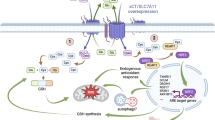Abstract
Background
Cysteine/histidine-rich 1 (CYHR1) was first discovered in a yeast two-hybrid screen with murine galectin-3, and no previous reports have described a relationship between the CYHR1 gene and human cancer. The current study evaluated the role and significance of CYHR1 in esophageal cancer.
Methods
The human esophageal squamous cell carcinoma (ESCC) cell line TE-8 and the CYHR1 knock-down cell line TE-8/small interfering (si)-CYHR1 were used for in vitro and in vivo assays. For clinical study, ESCC tissues (n = 104) were used.
Results
Compared with parental cells, TE-8/si-CYHR1 cells had suppressed proliferation and invasion activities. In the in vivo assay, the tumors from TE-8 cells treated with si-CYHR1 had abrogated tumorigenicity. In the clinical study, the expression of CYHR1 mRNA was associated with lymph node metastasis and stage and shown to be an independent prognostic factor.
Conclusions
As the findings show, CYHR1 may represent not only a valuable prognostic marker but also a therapeutic target for ESCC patients.




Similar content being viewed by others
References
[globocan.iarc.fr] GLOBOCAN database, 2008.
Jemal A, Bray F, Center MM, et al. Global cancer statistics. CA Cancer J Clin. 2011;61:69–70.
Bancewicz J, Clark P, Smith D, et al. Med Res Council Oesophageal Cnc. Surgical resection with or without preoperative chemotherapy in oesophageal cancer: a randomized controlled trial. Lancet. 2002;359:1727–33.
Kelsen DP, Ginsberg R, Pajak TF, et al. Chemotherapy followed by surgery compared with surgery alone for localized esophageal cancer. N Engl J Med. 1998;339:1979–84.
Sobin LH, Wittekind C. International Union Against Cancer (UICC) TNM Classification of Malignant Tumours, vol. 6. New York: Wiley; 2002.
Sobin LH, Gospodarowicz MK, Wittekind C. International Union Against Cancer (UICC) TNM Classification of Malignant Tumours. vol. 7. New York: Wiley; 2010.
Tanaka F, Yamamoto K, Suzuki S, et al. Strong interaction between the effects of alcohol consumption and smoking on oesophageal squamous cell carcinoma among individuals with ADH1B and/or ALDH2 risk alleles. Gut. 2010;59:1457–64. doi:10.1136/gut.2009.205724
Ohta M, Mimori K, Fukuyoshi Y, et al. Clinical significance of the reduced expression of G protein gamma 7 (GNG7) in oesophageal cancer. Br J Cancer. 2008;98:410–17. doi:10.1038/sj.bjc.6604124
Yoshinaga K, Mimori K, Inoue H, et al. Activin A enhances MMP-7 activity via the transcription factor AP-1 in an esophageal squamous cell carcinoma cell line. Int J Oncol. 2008;33:453–9.
Kita Y, Mimori K, Iwatsuki M, et al. STC2: A predictive marker for lymph node metastasis in esophageal squamous-cell carcinoma. Ann Surg Oncol. 2011;18:261–72. doi:10.1245/s10434-010-1271-1
Nishida N, Mimori K, Yokobori T, et al. FOXC2 is a novel prognostic factor in human esophageal squamous cell carcinoma. Ann Surg Oncol. 2011;18:535–42. doi:10.1245/s10434-010-1274-y
Kogo R, Mimori K, Tanaka F, et al. FBXO31 determines poor prognosis in esophageal squamous cell carcinoma. Int J Oncol. 2011;39:155–9. doi:10.3892/ijo.2011.1018
Yokobori T1, Mimori K, Iwatsuki M, et al. Copy number loss of FBXW7 is related to gene expression and poor prognosis in esophageal squamous cell carcinoma. Int J Oncol. 2012;41:253–9. doi:10.3892/ijo.2012.1436.
Sudo T, Iwaya T, Nishida N, et al. Expression of mesenchymal markers vimentin and fibronectin: the clinical significance in esophageal squamous cell carcinoma. Ann Surg Oncol. 2013;20(Suppl 3):S324–35. doi:10.1245/s10434-012-2418-z
Sawada G, Takahashi Y, Niida A, et al. Loss of CDCP1 expression promotes invasiveness and poor prognosis in esophageal squamous cell carcinoma. Ann Surg Oncol. 2014.
Menon RP, Strom M, Hughes RC. Interaction of a novel cysteine and histidine-rich cytoplasmic protein with galectin-3 in a carbohydrate-independent manner. FEBS Lett. 2000;470:227–31.
Bawumia S, Barboni EA, Menon RP, et al. Specificity of interactions of galectin-3 with Chrp, a cysteine- and histidine-rich cytoplasmic protein. Biochimie. 2003;85:189–94.
Calvo JH, Marcos S, Beattie AE, et al. Linkage mapping of ovine cysteine and histidine-rich protein gene (CYHR1) to chromosome 9. Anim Genet. 2004;35:263–4.
Kaupe B, Kollers S, Fries R, et al. Mapping of CYB11B and a putative CYHR1 paralogous gene to bovine chromosome 14 by FISH. Anim Genet. 2004;35:478–9.
Nishimura T, Hashimoto Y, Katayama M, et al. Molecular and cellular features of esophageal cancer cells. J Cancer Res Clin Oncol. 1993;119:441–9.
Shimada Y, Imamura M, Wagata T, et al. Characterization of 21newly established esophageal cancer cell lines. Cancer. 1992;69:277–84.
Berg JM. Potential metal-binding domains in nucleic acid binding proteins. Science. 1986;232:485–7.
Frankel AD, Berg JM, Pabo CO. Metal-dependent folding of a single zinc finger from transcription factor IIIA. Proc Natl Acad Sci USA. 1987;84:4841–5.
Parraga G, Horvath SJ, Eisen A, et al. Zinc-dependent structure of a single-finger domain of yeast ADR1. Science. 1988;241:1489–92.
Aronson BD, Somerville RL, Epperly BR, et al. The primary structure of Escherichia coli l-threonine dehydrogenase. J Biol Chem. 1989;264:5226–32.
Ly-Huynh JD, Lieu KG, Major AT, et al. Importin alpha2-interacting proteins with nuclear roles during mammalian spermatogenesis. Biol Reprod. 2011;85:1191–202. doi:10.1095/biolreprod.111.091686
LaCasse EC, Baird S, Korneluk RG. The inhibitors of apoptosis (IAPs) and their emerging role in cancer. Oncogene. 1998;17:3247–59.
Ambrosini G, Aidida C, Altieri DC. A novel anti-apoptosis gene, survivin, expressed in cancer and lymphoma. Nat Med. 1997;3:917–21.
Akahani S, Nangia-Makker P, Inohara H, et al. Galectin-3: A novel antiapoptotic molecule with a functional BH1 (NWGR) domain of Bcl-2 family. Cancer Res. 1997;57:5272–6.
Subramanian A, Tamayo P, Mootha VK, et al. Gene set enrichment analysis: a knowledge-based approach for interpreting genome-wide expression profiles. Proc Natl Acad Sci USA. 2005;102:15545–50.
Mizuno H, Kitada K, Nakai K, Sarai A. PrognoScan: A new database for meta-analysis of the prognostic value of genes. BMC Med Genomics. 2009;2:18.
Acknowledgments
This study was supported by a Grant-in-Aid for Scientists from the Ministry of Education, Culture, Sports, Science, and Technology of Japan (Grant No. 24591954).
Conflict of Interest
There are no conflicts of interest.
Author information
Authors and Affiliations
Corresponding author
Electronic supplementary material
Below is the link to the electronic supplementary material.
Rights and permissions
About this article
Cite this article
Desaki, R., Sawada, G., Okumura, H. et al. As a Novel Prognostic Marker, Cysteine/histidine-rich 1 (CYHR1) is a Therapeutic Target in Patients with Esophageal Squamous Cell Carcinoma. Ann Surg Oncol 24, 586–593 (2017). https://doi.org/10.1245/s10434-015-5031-0
Received:
Published:
Issue Date:
DOI: https://doi.org/10.1245/s10434-015-5031-0




